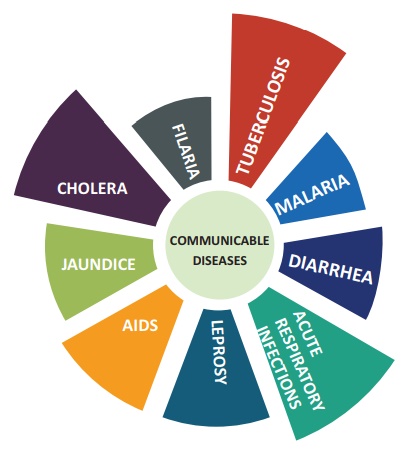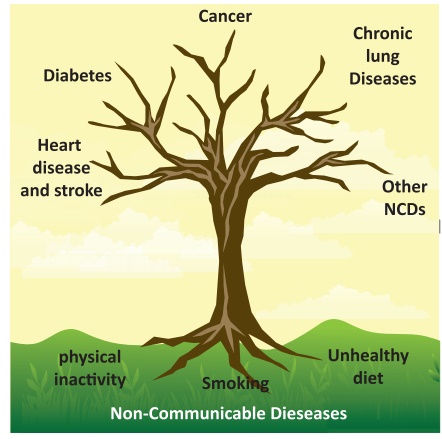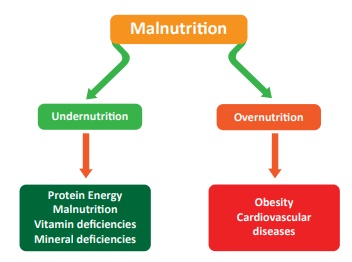Chapter: 12th Nursing : Chapter 9 : Community Health Nursing
Health problems in India
Health problems in india
Poor health is a major problem in India which contributes to the
many health problems. Following are three causes of poor health in India.
·
High Birth Rate and
Rapid Growth of Population
·
Malnutrition
·
Unsanitary Conditions
and Housing
Health problems are classified in to
·
Communicable disease
·
Non-communicable
diseases
·
Nutritional Problems
·
Environmental Sanitation
problems
·
Medical Care Problems
·
Population Problems
1. Communicable Diseases Problem:
Communicable diseases continue to be the major problem in India,
but many of them are controlled in developed countries such as USA. It is
estimated that nearly 54% of deaths in India are due to communicable diseases.
Common communicable diseases found in India are

I. Malaria
Till today Malaria is a major health problem in India which is a
big challenge to eliminate and control. Malaria is transmitted by the bites of
infected female anopheles mosquito(Parasite). If not treated properly which can
become life threatening. The National Malaria Control and Eradication
Programmes launched in 1953 and 1958 respectively. During 2016 1.09 millon
cases were reported and about 331 deaths were registered due to malaria.
Whereas the scenario in 2017 was about 0.84 millon cases were reported and
about 194 deaths were registered dut to malaria
II. Tuberculosis
Tuberculosis is a leading communicable disease in India accounting
for one-fifth of the world incidence. Pulmonary Tuberculosis is contagious
bacterial infection caused by
Mycobacterium Tubercle, which mainly affects lung. According to
the Global TB report 2017 the estimated incidence of TB in India was
approximately 28,00,000 accounting for about a quarter of the world’s TB cases.
Every year about 1.2 million persons develop Tuberculosis of which 0.64 million
cases are sputum positive which is highly infectious and 0.32 million people
die due to TB. The emergence of HIV-TB co-infection and multidrug resistant TB
has become a challenge today.
 III. Diarrheal Diseases
III. Diarrheal Diseases
Diarrheal diseases constitute one of the major causes of sickness
and death specially in children below 5 years of age accounting for
approximately 8% of all deaths among children below 5 years worldwide in 2016.
Outbreaks of diarrheal diseases including cholera continue to occurs due to the
poor environmental conditions. Diarrheal diseases are caused by viral,
bacterial and parasitic organisms.
IV. Acute Respiratory Infections (ARI)
Acute respiratory diseases are one of the major causes of sickness
and death in children below 5 years of age. During 2011, nearly 26.3 million
episodes of Acute Respiratory Infection were reported with 2,492 deaths.
V. Leprosy
Leprosy is a chronic infectious disease which is caused by
Mycobacterium Leprae. It mainly affects the skin, the peripheral nerves, the
mucosa of the upper respiratory tract and the eyes. It is curable when the
treatment started in the early stages prevents disability. Multidrug therapy,
made available by WHO free of cost to all patients worldwide since 1995,
provides a simple but highly effective cure for all types of leprosy. Control
of leprosy has improved significantly by Integration of basic leprosy services
into general health services to diagnose and provide treatment of the disease
within easy reach(PHC). WHO has launched a new global strategy in 2016 –2020:
accelerating towards a leprosy-free world – which aims to leprosy control and
prevent disabilities.
VI. Acquired Immuno Deficiency Syndrome(AIDS)
Since AIDS was first detected in the year 1986 and worldwide it
stands in third place. It is estimated that by the end of year 2016, there were
about 2.1million cases of HIV positive cases and 62000 people died from AIDS
related illnesses in the country.
2. Non Communicable Diseases Problem (NCD)

NCDs are the leading cause of death in the world, responsible for
63% of the 57 million deaths that occurred in 2008.The majority of these deaths
are due to cardiovascular diseases and diabetes, cancers and chronic
respiratory diseases. More than nine million of all deaths attributed to
noncommunicable diseases (NCDs) occur before the age of 60. Behavioral risk
factors, including tobacco use, physical inactivity, and unhealthy diet, are
responsible for about 80% of coronary heart disease and cerebro vascular
disease.
Millions of deaths due to Non Communicable Diseases which can be
prevented by promoting the public awareness and participation.
Measures to Control Non Communicable Disease
·
Stronger anti-tobacco
controls - No smoking
·
Promoting healthier
diets
·
Promoting Physical
activity
·
Reducing/Stop the use of
alcohol;
·
Improving people's
access to essential health care.
3. Nutritional Problems
According to WHO, "Malnutrition refers to deficiencies,
excess or imbalances in a person's intake of energy and/or nutrients"
Malnutrition covers two broad spectrums of under nutrition and
over nutrition.
Undernutrition: Refers to lack of proper nutrition, caused by not
having enough food or not eating enough food containing substances necessary
for growth and health.
Over nutrition: Is a form of Malnutrition in which nutrients are
oversupplied relative to the amounts required for normal growth, development
and metabolism.

According to World Bank report, India is ranking 2nd in the world
of the number of children suffering from malnutrition (i.e. Under weight
(43.5), Stunting (47.9), Wasting (20) and overweight (1.9)).
Source: Asamadu et al, Nutritional Problems and Intervention
Strategies in India, A technical Report (2012)
a)
Protein Energy
Malnutrition- : Caused by the defeciencies of protein and calories. It
occurs more commonly among weaned infants and pre school children
Kwashiorkor is the deficiency of protein in the diet.
Marasmus - severe deficiency of protein and energy in the diet.
b) Vitamin Defeciencies: caused by the deficiency
of vitamins in the diet.
·
Vitamin A deficiency –
leads to Night blindness and Xerophthalmia( dryness of cornea)
·
Vitamin C deficiency –
leads to Scurvy
·
Vitamin D deficiency –
leads to Rickets
c) Mineral defeciencies: caused by the deficiency
of minerals in the diet
·
Nutritional anemia –
decreased haemoglobin in the blood due to the insufficient iron in the diet
·
Iodine deficiency
disorder (Goitre) – decreased iodine intake.
d) Out of these defeciencies the two major nutritional
problems of India are
·
Under
Nutrition
·
Nutritional
Anaemia
4. Environmental Sanitation problem
Environmental sanitation is the most difficult problem to handle
in our country which is multi-factorial and multifaceted.
Major environmental problems in India are
·
Air and water pollution
·
Depletion of natural
resources
Improper waste disposal and low level of sanitation leads to soil
pollution and breeding places of insects, flies and rodents.
·
Sound pollution Traffic
pressure.
·
Degradation of land
Industrialization and urbanization
·
Radiation hazards
·
Excessive use of
fertilizers and chemicals in agriculture.
·
Destruction of forests
·
Increasing population,
poverty, illiteracy,
·
unemployment further
increases environmental problems.
5. Medical Care Problems
In rural area 74% population doesn’t get benefit of modern
curative and preventive health services. Approximately 80% of health services
are concentrated in urban area. Addressing to meet inadequate and uneven
distribution of doctors, and medical services between rural and urban is the
challenging task to health sector.
6. Population Problem
During Independence in 1947 India's Population was 30 crores. As
on 2018 now it is the second most populated country in the world, current
population is 1.35 billion. The population problem is the important problem
faced by our country which affects all aspects of, sanitation, housing, health
care and environment.

Related Topics